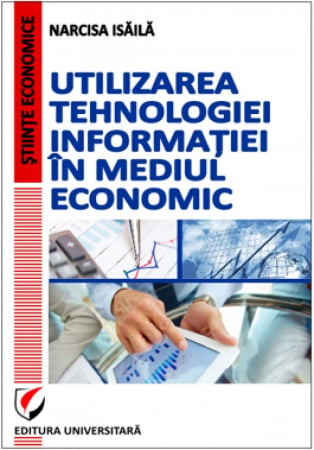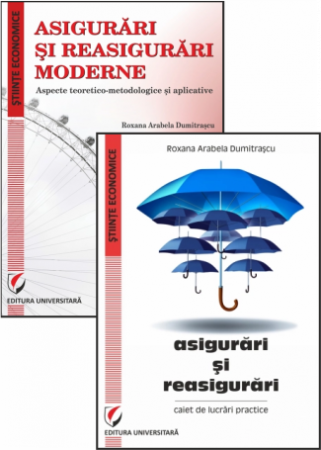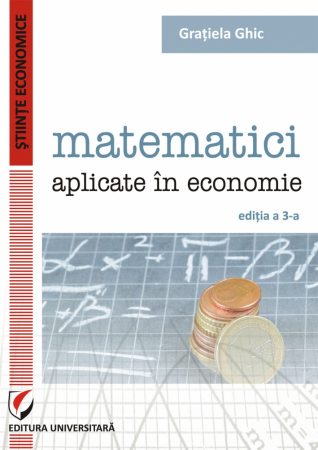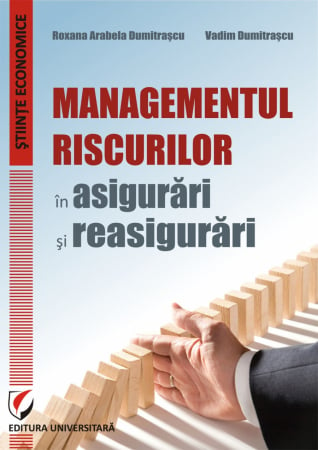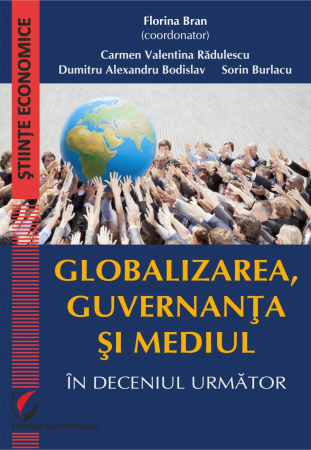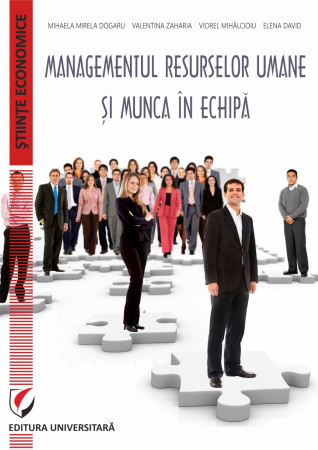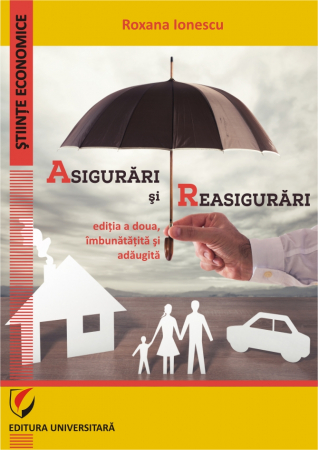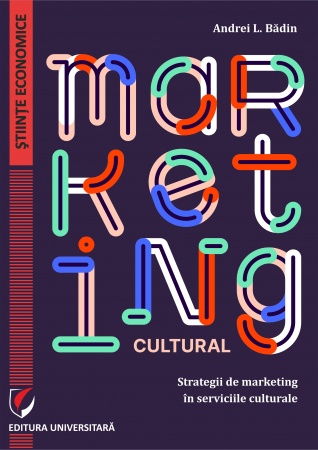ISBN: 978-606-28-0948-5
DOI: 10.5682/9786062809485
Publisher year: 2019
Edition: I
Pages: 368
Publisher: Editura Universitară
Author: Ion Verboncu
- Description
- Download (1)
- Authors
- Content
- More details
- Reviews (0)
The book offered to our readers tries a unique approach to the organization's management issues, in the sense that the 360 questions receive answers, and these are commented, so that the understanding of the answers is facilitated. We stopped at 360 questions to "catch" the most significant aspects that management theory and practice entail and, in this way, to provide an overview of this area of utmost importance for each of us.
We are in a situation where, seeing what is happening in Romanian society and economy, we refer to Peter Drucker, one of the most famous management specialists in the world, who states that "there are no rich and poor countries, but well-run countries and badly conducted ”. Despite the pace of economic growth above the European average, there are huge gaps in many respects: we do not have the desired road and rail infrastructure, we do not have enough properly equipped hospitals, the quality of education is questioned, specialists migrate to other countries and the economy Romania is facing an acute personnel crisis, the services provided to the population are not of the best quality, we do not know how to properly capitalize on what we produce and so on All these are, directly or indirectly, related to the quality and efficiency of management. We need more than ever a professional management, exercised by managers also professional, at all organizational levels of the company.
Our paper refers to the organization, but many of the aspects approached in response to the questions raised are also valid in the macrosystem of which it is part.
I designed the paper in the form of questions. The list is not exhaustive. It couldn't be. In our opinion, the 360 questions are representative of management. We also offer them annotated answers, which refer both to the author's conception in this field, and to the opinions, most of the times, quite recent, of the notorious specialists, from Romania and from other countries.
The six parts of our paper include already established, traditional aspects of management, as theory and practice, but also elements of novelty, such as those related to some managerial innovations that hold the headline in many countries with advanced economics: organization and management based on knowledge, holacracy, free enterprise, digital enterprise, its rendanheyi system These are just some of the responses of managerial practice to the challenges of the period we are going through, characterized by a much faster dynamics of changes in the environment of the organization, nationally and internationally, compared to the changes that occur within it.
-
MANAGEMENTUL ORGANIZATIEI in 360 de intrebari si raspunsuri comentate
Download
Professor emeritus at the Academy of Economic Studies in Bucharest, he was born on July 11, 1953 in Tismana, Gorj County and is a graduate of the Faculty of Economics of Industry, Construction and Transport, as head of promotion, in 1976. He went through all university levels, from to assistant to university professor, to the Department of Management within the Faculty of Management. Since 2018 he is Doctor Honoris Causa of the Cooperative-Commercial University of Chisinau. The over four decades of university career have resulted in notable achievements in the field of scientific research (including research for education), teaching, professional and services to the academic community.
The scientific research has materialized in the publication of over 270 specialized articles, more than half of which are indexed by the Web of Science and BDI or in the volumes of international scientific events.
The didactic and professional activity includes numerous management books, as sole author (How do we lead? Between amateurism and professionalism; Managerial redesign of the organization; Management & managers; Do we know how to lead ?; Strategic management of public organizations) (Cum conducem? Intre amatorism si profesionalism; Reproiectarea manageriala a organizatiei; Management & manageri; Stim sa conducem?; Managementul strategic al organizatiilor publice s.a.), sole coordinator and main author ( Efficiency, effectiveness, performance; Public management; Management and performance, etc.) (Management. Eficienta, eficacitate, performante; Management public; Management si performante etc.), the second author (such as Fundamentals of organization management; Managerial methodologies) (Fundamentele managementului organizatiei; Metodologii manageriale), coordinator and author (Management dictionary; Modern approaches in economics and organization management, etc.) (Dictionar de management; Abordari moderne in economia si managementul organizatiei etc.) co-author in reference volumes for Romanian management (Company management strategies; Management systems, methods and techniques; Company decision-making system; Managers and human resources management; Contributions to the creation of a Romanian management model) (Strategii manageriale de firma; Sisteme, metode si tehnici de management; Sistemul decizional al firmei; Managerii si managementul resurselor umane; Contributii la crearea unui model romanesc de management s.a.)..
Foreword / 17
I. MANAGEMENT - SCIENCE OR ART? / 19
1. What is management? / 19
2. Is management a science or an art? / 19
3. How can management be approached? / 21
4. What is scientific management? / 22
5. Are there differences between management and administration? / 22
6. What is the fundamental condition of the exercise of management? / 22
7. What are management processes? / 2. 3
8. What is the significance of the management process sequences, called functions or attributes? / 2. 3
9. What is the content of the forecast? / 2. 3
10. Why / what / forecast is the most important function of management? / 24
11. What is organization? / 25
12. Why / why / organization is the most vulnerable function of management? / 26
13. How is the vulnerability of the organization manifested? / 27
14. What is coordination? / 28
15. How is communication defined? / 28
16. How is the quality of coordination ensured? / 29
17. Why is coordination the most pleasant function? / 30
18. What is training? / 30
19. What about motivation? / 30
20. Why is training considered the most difficult of management functions? / 31
21. What is control-evaluation? / 32
22. Why is control-evaluation the most boring function of management? / 32
23. What is the managerial cycle? / 32
24. What are the most significant malfunctions in the exercise of forecasting? / 33
25. What dysfunctions does the organizing function register? / 33
26. What dysfunctions occur in the exercise of coordination? / 33
27. Are they deficient in training? / 34
28. What dysfunctions are registered in the control-evaluation exercise? / 34
29. What are management relationships? / 35
30. What are the management principles? / 35
II. MANAGERS - SUBJECT OF MANAGEMENT / 37
31. What is the manager? / 37
32. What is the significance of the notions of boss, responsible, coordinator? / 37
33. How do you become a manager? / 38
34. How is the executor defined? / 39
35. What roles does the manager play? / 40
36. What are the roles of the executor? / 40
37. What is the exercise of management processes? / 41
38. What are the essential differences between manager and executor? / 43
39. What is the leader? / 46
40. What are the differences between managers and leaders? / 46
41. What is the significance of the type of manager and the management style? / 48
42. What types of managers and management styles exist? / 48
43. What are leadership and managerial leadership? / 49
44. Is time the most important resource for managers? / 51
45. How is time used? / 51
46. What major dysfunctions occur in the use of the time budget? / 52
47. What causes such dysfunctions? / 53
48. How can the performance of managers be made more efficient? / 54
49. What does the scientific programming and organization of work mean? / 54
50. What is a to-do list? / 55
51. What is the essence of the GTD method? / 56
52. What is the manager's ergonomics? / 57
53. How can relations with subordinates be improved? / 59
54. What is the management secretariat? / 59
55. Secretary or assistant manager? / 60
56. Who are the modern collaborators of the manager? / 62
III. ORGANIZATION - OBJECT OF MANAGEMENT / 63
57. What is the organization? / 63
58. What is a company? / 63
59. What are public organizations? / 64
60. What types of organizations operate in Romania? / 65
61. What is the systemic approach of the organization? / 66
62. What are the processes? / 67
63. What is the typology of the organization's processes? / 67
64. What are the main processes? / 67
65. What is the significance of the support or support processes? / 68
66. What is corporate social responsibility? / 68
67. What are the objectives? / 70
68. How are the objectives substantiated? / 70
69. What characteristics must the objectives meet? / 71
70. How to cascade (break down) the objectives within the organization? / 72
71. What is corporate governance? / 73
72. What managerial organization systems work in Romania? / 73
73. What is the unitary type of organization? / 74
74. What is the content of the dualistic system? / 75
75. How is a new business (a new enterprise) set up? / 76
76. What are insolvency and bankruptcy? / 77
77. Why do Romanian companies go bankrupt? / 78
78. What is the environment of the organization? / 78
79. What do economic variables contain? / 79
80. What is the content of management factors? / 80
81. What are the technical and technological factors of the environment? / 81
82. What are socio-cultural variables? / 81
83. What are the demographic factors? / 82
84. What are political factors? / 82
85. What natural factors act on the organization? / 83
86. What are the legal factors? / 83
IV. ORGANIZATION MANAGEMENT - SYSTEMIC APPROACH / 85
A. Managerial tools and managerial methodologies / 85
87. What is the management system of the organization? / 85
88. What are the major components of the management system? / 85
89. What does the methodological subsystem of management contain? / 86
90. What is the managerial tool? / 86
91. What is the difference between the complex method (system), the method and the management technique? / 86
92. What are the roles of managerial tools? / 87
93. What is the significance of managerial methodologies? / 87
94. What is the content of management standards? / 88
95. What are the procedures? / 88
96. What complex management methods (systems) are recommended for Romanian organizations? / 89
97. What is goal management? / 90
98. What are the components of management by objectives? / 91
99. What methodological sequences have its promotion and use? / 91
100. What is management based on profit centers? / 92
101. What are the differences between management by objectives and management based on profit centers? / 94
102. What are the elements that make it necessary and opportune to call the management on profit centers? / 95
103. What characterizes the management on profit centers? / 96
104. When is it recommended to use management on profit centers? / 97
105. What is the methodology for operationalizing management based on profit centers? / 99
106. What is the content of the enterprise budget? / 100
107. What is the business format? / 101
108. How are the management centers (task formats) delimited and dimensioned? / 101
109. What is the budget content of a business format? / 104
110. How to launch budgets on management centers (business formats)? / 106
111. What is the budget execution? / 106
112. How are the evaluation and analysis of the results and the motivation of the employees done? / 109
113. What does an evaluation and motivation grid include? / 110
114. What are the advantages of using MO and MCP? / 111
115. What are the main limits of their operationalization? / 112
116. What is the stage of promoting the two complex methods in Romania? / 113
117. What novelties are in the promotion and use of management by objectives and management by profit centers? / 115
118. What is budget management? / 119
119. What are the stages of promoting and using budget management? / 120
120. What is the typology of budgets? / 121
121. What are the advantages and limitations of budget management? / 122
122. What is the cost-time-production (SCOP) system? / 122
123. What characterizes SCOP? / 123
124. What are the / main / methodological landmarks / of the cost-hour-production system? / 125
125. What are the advantages and limitations of the cost-hour-production system? / 128
126. What is project management? / 129
127. What is the project? / 130
128. What / differences / exist / between project management and project management? / 131
129. What organizational variants of project management exist? / 132
130. What characterizes management through facilitated projects? / 132
131. What is the management through projects with individual responsibility? / 133
132. What is project management with staff? / 135
133. What about mixed project management? / 136
134. What / is / the / content / methodology / for promoting and operationalizing project management? / 137
135. What is the key character of project management? / 139
136. What are the advantages and limitations of project management? / 141
137. What is exception management? / 142
138. In what situations is it recommended to use management by exceptions? / 143
139. How is exception management applied? / 144
140. What working tools are used in exception management? / 145
141. What are the advantages and limitations of exception management? / 147
142. What management methods and techniques can be used in Romanian organizations? / 147
143. What is the diagnosis? / 148
144. What are the hypostases of diagnosis? / 148
145. What is the result of the diagnosis? / 149
146. What types of diagnoses can the organization use? / 149
147. Who prepares the diagnostic study? / 150
148. When is diagnosis used? / 150
149. How is a diagnostic study developed? / 151
150. What does the preparation for diagnosis entail? / 151
151. What is the content of the preliminary documentation? / 152
152. What does the analysis of managerial and economic viability contain? / 157
153. What is the analysis of managerial viability? / 158
154. How is the economic viability analysis performed? / 164
155. What is a symptom? / 165
156. How is a strong point defined? / 165
157. But a weak point? / 165
158. What is the opportunity? / 166
159. How is the threat (vulnerability) defined? / 166
160. How is the viability potential of the organization determined? / 166
161. What is the mechanism for determining the importance coefficients? / 168
162. What is the significance of the viability potential? / 168
163. What are the recommendations? / 169
164. What / mistakes / are made in the elaboration / writing of the diagnostic study? / 169
165. What is SWOT analysis? / 170
166. What are the methodological steps of using SWOT analysis? / 170
167. What does the SWOT matrix look like? / 171
168. What is the significance of the four categories of combinations? / 172
169. What are the similarities between SWOT diagnosis and analysis? / 172
170. What are the differences between diagnosis and SWOT analysis? / 173
171. What is delegation? / 175
172. Is it correct to use the term "delegation"? / 175
173. Why delegate managers? / 175
174. When is delegation used? / 176
175. What are the characteristics of delegation? / 177
176. What are the components of delegation? / 177
177. How do we use delegation? / 178
178. What rules must be followed? / 180
179. What styles of delegation are recommended? / 180
180. What are the advantages and limitations of delegation? / 181
181. What is a meeting? / 183
182. What types of meetings can be organized and held? / 183
183. What are the methodological landmarks of the meeting? / 184
184. What dysfunctions characterize a meeting? / 186
185. How to ensure the success of a meeting? / 188
186. What are the advantages and limitations of the meeting, as a management method? / 189
187. What is the dashboard? / 189
188. Dashboard or balanced scoercard? / 191
189. When is the instrument panel used? / 192
190. What are the functions of the instrument panel? / 193
191. What is the dashboard typology? / 194
192. What are the characteristics of the dashboard? / 195
193. How is the information in the dashboard viewed? / 196
194. What methodology of use is recommended for the dashboard? / 198
195. What does the design of the dashboard entail? / 198
196. How to complete the dashboard? / 203
197. What is the use of the instrument panel? / 205
198. What are the advantages and limitations of using the dashboard? / 206
199. What methods are used in management? / 207
200. What methods can be used to stimulate creativity? / 207
201. What are the representative methods of cost management? / 208
202. What is benchmarking? / 209
203. How are benchmarking comparisons made? / 211
204. What / main / functions does the methodological component of management have? / 215
B. The decisional component of management / 216
205. What does the decision-making subsystem contain? / 216
206. What is the decision? / 216
207. What is the management decision or the managerial decision? / 216
208. What are the characteristics of the managerial decision? / 217
209. What types of management decisions can be made in an organization? / 217
210. What are certain decisions? / 218
211. What characterizes uncertain decisions? / 219
212. What are risk decisions? / 219
213. What differentiates strategic decisions from tactical and current ones? / 219
214. What are group decisions and individual decisions? / 220
215. What are the differences between multicriteria and unicriteria decisions? / 220
216. Advised decisions or unadvised decisions? / 220
217. What are anticipated decisions and unpredictable decisions? / 221
218. Are there differences between higher, middle and lower level decisions? / 221
219. How are periodic, random and unique decisions characterized? / 221
220. What is the quality of managerial decisions and how is it expressed? / 222
221. What are the decision-making mechanisms used? / 223
222. Optimization methods or decision methods? / 223
223. What methods are used for decisions taken under certainty? / 224
224. How can the ELECTRE method be operationalized? / 227
225. What novelties does the Onicescu method bring? / 228
226. What is the additive method? / 230
227. How is the global utility method applied? / 230
228. What are the particularities of the K coefficient (criterion) method? / 231
229. How can group decisions be optimized? / 232
230. What / methodological / particularities / has / the / three-dimensional / ELECTRE method? / 232
231. How is the Deutch & Martin algorithm operationalized? / 234
232. What methods (techniques) are used to optimize uncertain decisions? / 235
233. What methods can be used to optimize risk decisions? / 238
234. What are the functions of the decision-making component in the management of the organization? / 239
C. The informational component of management / 240
235. What is the information system? / 240
236. What is information? / 240
237. What is the typology of information? / 240
238. What are information circuits? What about information flows? / 242
239. What typology of information circuits and flows exist? / 242
240. What are information procedures? / 242
241. What are the means of processing information? / 243
242. What are the functions of the information system? / 243
D. Organizational component of management / 244
243. What does the organizational system contain? / 244
244. What is the procedural organization? / 244
245. What are the procedural components of the organization? / 245
246. What is structural organization? / 246
247. What about the organizational structure? / 246
248. What are the components of structural organization? / 246
249. How is fasting defined? / 247
250. What is the function? / 247
251. What is the compartment? / 247
252. What is the hierarchical level? / 248
253. What about the hierarchical weight? / 248
254. What are organizational relations? / 249
255. What types of organizational structures exist? / 249
256. What characterizes the hierarchical or simple organizational structure? / 50
257. What is the hierarchical-functional organizational structure? / 251
258. What does the matrix structure imply? / 252
259. What is the divisional structure? / 254
260. What is the hybrid organizational structure? / 255
261. What organizational documents are used? / 255
262. What is the process map? / 256
263. What is the content of the job description? / 256
264. What are the elements to support the achievement of individual objectives? / 261
265. What mistakes are made in the elaboration and updating of the job description? / 262
266. What does the organization and functioning regulation contain? / 263
267. What are the common mistakes in developing and updating ROF? / 267
268. What is the organization chart? / 268
269. What types of flowcharts are used? / 269
270. Are there any mistakes in the elaboration of the organizational chart? / 270
271. What functions does the organizational component have in the management of the organization? / 270
E. Human resources management / 271
272. What is human resources management? / 271
273. What is staff loyalty? / 272
274. What is organizational culture? / 273
275. What forms of manifestation does it have? / 274
276. What are the types of organizational culture? / 274
277. What functions do human resources management and organizational culture fulfill? / 275
V. EFFICIENCY OF ORGANIZATION MANAGEMENT / 276
A. Quality, efficiency and effectiveness of management / 276
278. How are the efficiency and effectiveness of management defined? / 276
279. How is the efficiency of management expressed? / 277
280. What performance indicators are used to express the efficiency of the methodological component of management? / 278
281. How is the efficiency of the (sub) decision-making system determined? / 279
282. How is the efficiency of the (sub) information system expressed? / 280
283. Can the efficiency of the organizational component be determined? / 281
284. How is the efficiency of human resources management expressed? / 282
285. What is the quality of management? / 283
286. What are the hypostases of management quality? / 285
287. Is management a decisive factor in increasing the efficiency of the organization? / 286
288. What does poor management mean? / 287
289. What ways to streamline management exist? / 287
B. Promoting strategic management / 288
290. What is the strategy of the organization? / 288
291. What are the components of the strategy? / 289
292. What is the mission? / 289
293. What is the most important component of the strategy? / 289
294. What are the ways to achieve the strategic objectives? / 290
295. What types of resources are used? / 290
296. What is the competitive or competitive advantage / 290
297. What are the criteria for classifying organizational strategies? / 291
298. What types of strategies can be substantiated and elaborated depending on the scope? / 292
299. What is the typology of the strategies delimited in relation to the dynamics of the objectives? / 292
300. What types of strategies derive from the type of objectives and the nature of the main strategic options? / 293
301. What types of strategies does the criterion “nature of vision, objectives and strategic options” lead to? / 293
302. How does the degree of involvement of the organization in the typology of strategies contribute? / 293
303. What are the types of strategies delimited according to the way of obtaining the competitive advantage? / 293
304. What variables influence the elaboration of the strategy? / 294
305. What are the sequences of strategic management? / 295
306. How is the organization's strategy substantiated? / 295
307. Who are the stakeholders of the organization? / 296
308. How does the life cycle phase influence the organization's strategy? / 296
309. What information is provided by the diagnostic study and / or SWOT analysis? / 296
310. What is the informational role of market research? / 297
311. Why is ecological study necessary? / 297
312. How is the organization's strategy elaborated? / 298
313. Who develops the strategy? / 299
314. What aspects does the implementation of the strategy imply? / 299
315. How is the strategy evaluated? / 299
C. Managerial redesign / 300
316. How to conduct a business process reengineering study? / 300
317. What are the main contributions to the concept and methodology of business process reengineering? / 301
318. What is managerial redesign? / 305
319. What is the scope of managerial redesign? / 305
320. Are there differences between business process reengineering and organization management reengineering? / 306
321. Who conducts the managerial redesign study? / 307
322. When is it necessary to redesign the management of the organization? / 308
323. What methodological sequences does managerial reengineering go through? / 309
324. What is the triggering element of managerial redesign? / 310
325. What is the sequence of "objectives"? / 310
326. What happens in the sequence "processes"? / 311
327. What do "structures" mean? / 313
328. What does the “people” stage entail? / 314
329. What results are expected from the operationalization of the redesigned management? / 318
330. What are the differences between managerial reengineering and organizational restructuring? / 319
D. Managerial methodology / 321
331. What is managerial methodology? / 321
332. What / is / the / impact / of the managerial methodology on the scientificization of the managers' performance? / 322
333. What does the state of normalcy in managerial methodology imply? / 324
334. How is the managerial tool chosen? / 324
335. Are there differences in managerial methodology at the level of enterprise and public institution? / 325
E. Professionalization of managers and management / 326
336. What is the professionalization of managers and management? / 326
337. What is a professional manager? / 327
338. At what stage is the professionalization of managers and management of small and medium enterprises? / 328
339. What is the stage of professionalization of managers of public enterprises? / 329
340. Do we have professional managers in public institutions? / 330
341. Public management, between the Scylla of corruption and the Caribda of bureaucracy? 332
342. What are the differences between meritocracy and mediocrity? / 333
343. What are the ways to professionalize managers and management? / 335
344. What legislative particularities must be observed in the nomination of managers? / 336
345. What is the selection procedure for managers of public enterprises? / 337
346. How can human resources management be activated? / 340
347. How does managerial methodology contribute to the professionalization of managers and management? / 341
348. What / role / have / training / and / consulting in the professionalization of managers and management? / 342
349. How does professionalization contribute to improving the quality and efficiency of the organization's management? / 344
F. Improving the organizational and managerial culture / 345
350. How can organizational culture be changed? / 345
G. Depoliticization of management / 346
351. What solutions for depoliticizing the management of public organizations are there? / 346
H. Debureaucratization of management / 347
352. What is bureaucracy? / 347
353. How can the management of the organization be debureaucratized? / 348
VI. THE FUTURE OF ORGANIZATION MANAGEMENT / 351
354. What management systems are we heading towards? / 351
355. What are knowledge-based organization and management? / 352
356. What is "Enterprise 2.0"? / 354
357. What is the significance of the ROWE system? / 355
358. How is the released enterprise defined? / 356
359. What is holacracy? / 357
360. What is the Rendanheyi organizational model? / 359
Bibliography / 361
The book offered to our readers tries a unique approach to the organization's management issues, in the sense that the 360 questions receive answers, and these are commented, so that the understanding of the answers is facilitated. We stopped at 360 questions to "catch" the most significant aspects that management theory and practice entail and, in this way, to provide an overview of this area of utmost importance for each of us.
We are in a situation where, seeing what is happening in Romanian society and economy, we refer to Peter Drucker, one of the most famous management specialists in the world, who states that "there are no rich and poor countries, but well-run countries and badly conducted ”. Despite the pace of economic growth above the European average, there are huge gaps in many respects: we do not have the desired road and rail infrastructure, we do not have enough properly equipped hospitals, the quality of education is questioned, specialists migrate to other countries and the economy Romania is facing an acute personnel crisis, the services provided to the population are not of the best quality, we do not know how to properly capitalize on what we produce and so on All these are, directly or indirectly, related to the quality and efficiency of management. We need more than ever a professional management, exercised by managers also professional, at all organizational levels of the company.
Our paper refers to the organization, but many of the aspects approached in response to the questions raised are also valid in the macrosystem of which it is part.
I designed the paper in the form of questions. The list is not exhaustive. It couldn't be. In our opinion, the 360 questions are representative of management. We also offer them annotated answers, which refer both to the author's conception in this field, and to the opinions, most of the times, quite recent, of the notorious specialists, from Romania and from other countries.
The six parts of our paper include already established, traditional aspects of management, as theory and practice, but also elements of novelty, such as those related to some managerial innovations that hold the headline in many countries with advanced economics: organization and management based on knowledge, holacracy, free enterprise, digital enterprise, its rendanheyi system These are just some of the responses of managerial practice to the challenges of the period we are going through, characterized by a much faster dynamics of changes in the environment of the organization, nationally and internationally, compared to the changes that occur within it.
The classic, traditional management systems, with rigid, multi-storey organizational structures, deeply bureaucratic in the unfavorable sense of the term, are, in the opinion of an increasing number of specialists, outdated, ankylosed. Solutions are being sought, and the last 2-3 decades have "come" with some truly revolutionary proposals that will probably solve the lags from a managerial point of view.
The book is based, in proportion of over 50%, aspects presented a year ago in the work "How do we drive? Between amateurism and professionalism ", published in the University publishing house. To these, of course, we have added many other elements of novelty because management is one of the areas in which "novelty" has become a defining feature. What we have changed is the way of presenting these aspects, in the form of questions, answers and comments to the answers offered to readers. We considered that this way of presenting the current content of the organization's management is much more exciting, more interesting for the potential reader, be it a student, management specialist or manager, regardless of the position in the organization.
The author is aware that the appetite for specialized reading is reduced and limited to a small audience, that the market is invaded by hundreds or thousands of works in this field that create confusion even among connoisseurs. However, we believe that the concerns of management specialists should not stop here but, on the contrary, should be continued, including through the publication of books, articles, reviews, etc.
The book we offer for reading is such an approach. But few know that writing a specialty book means creativity and innovation, but also special efforts, a continuous search through what others have written. This requires support from those close to you, the family in the first place. Personally, I benefited from this support, from the love and patience of my wife who understood this hobby.
Also, to the staff of the University Publishing House, personally to the Director, Dr. Vasile Muscalu, who leaned carefully on the work and ensured its appearance in an attractive graphic form.
The Author
Bucharest, May 2019

6359.png)
![Organizational management in 360 questions and commented answers - Ion Verboncu [1] Organizational management in 360 questions and commented answers - Ion Verboncu [1]](https://gomagcdn.ro/domains/editurauniversitara.ro/files/product/large/managementul-organizatiei-in-360-de-intrebari-si-raspunsuri-comentate-127-370822.jpg)

